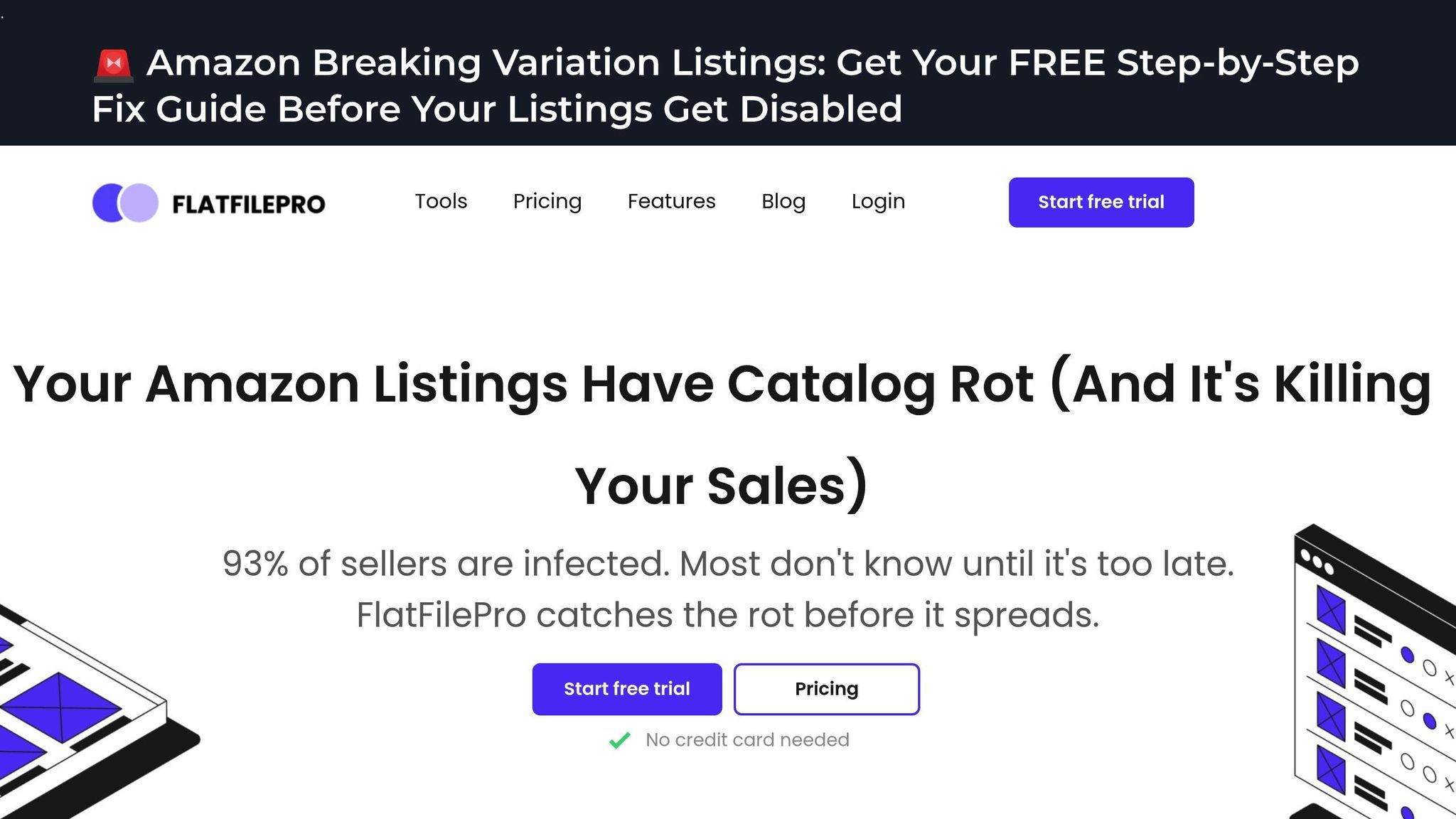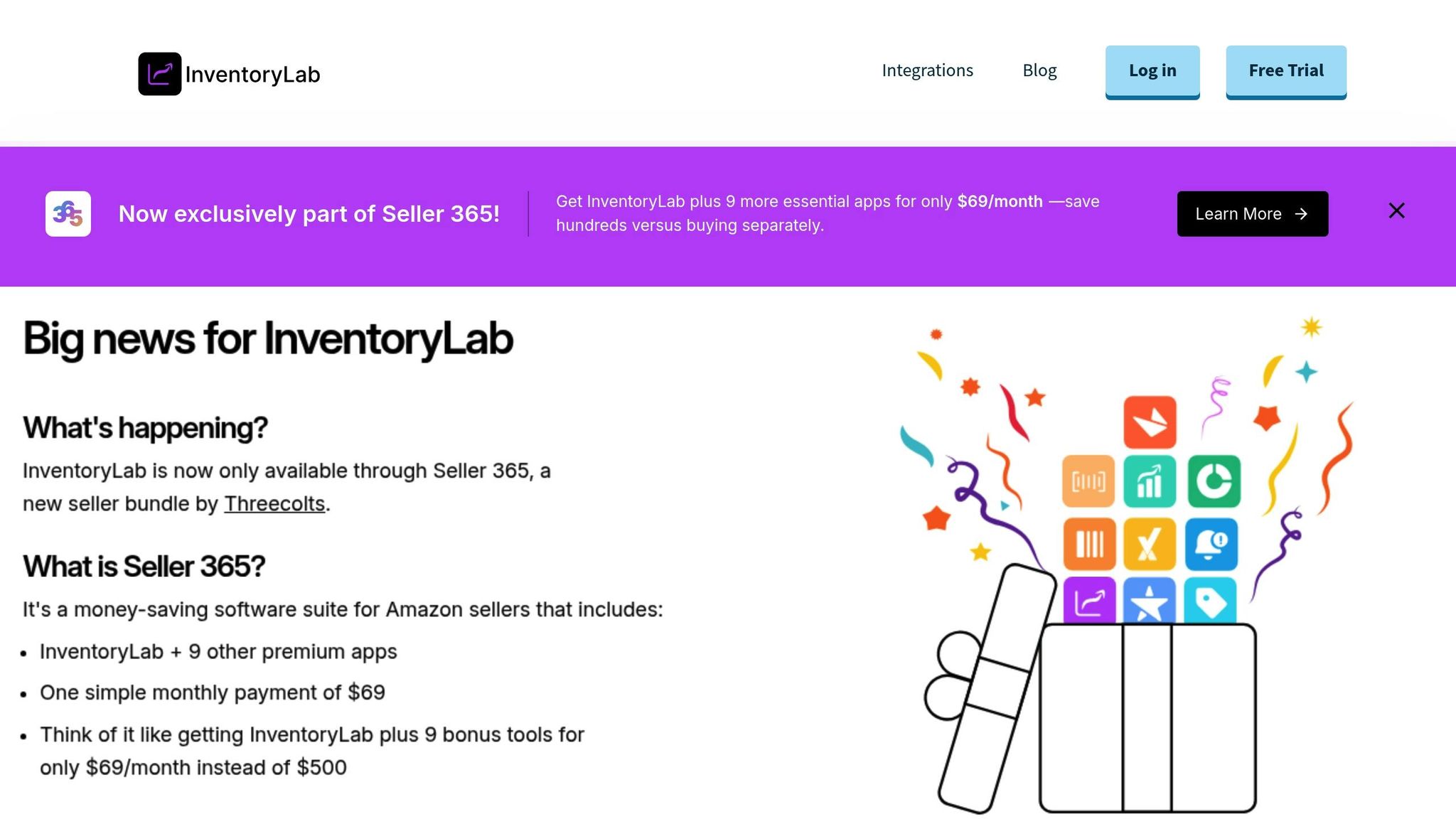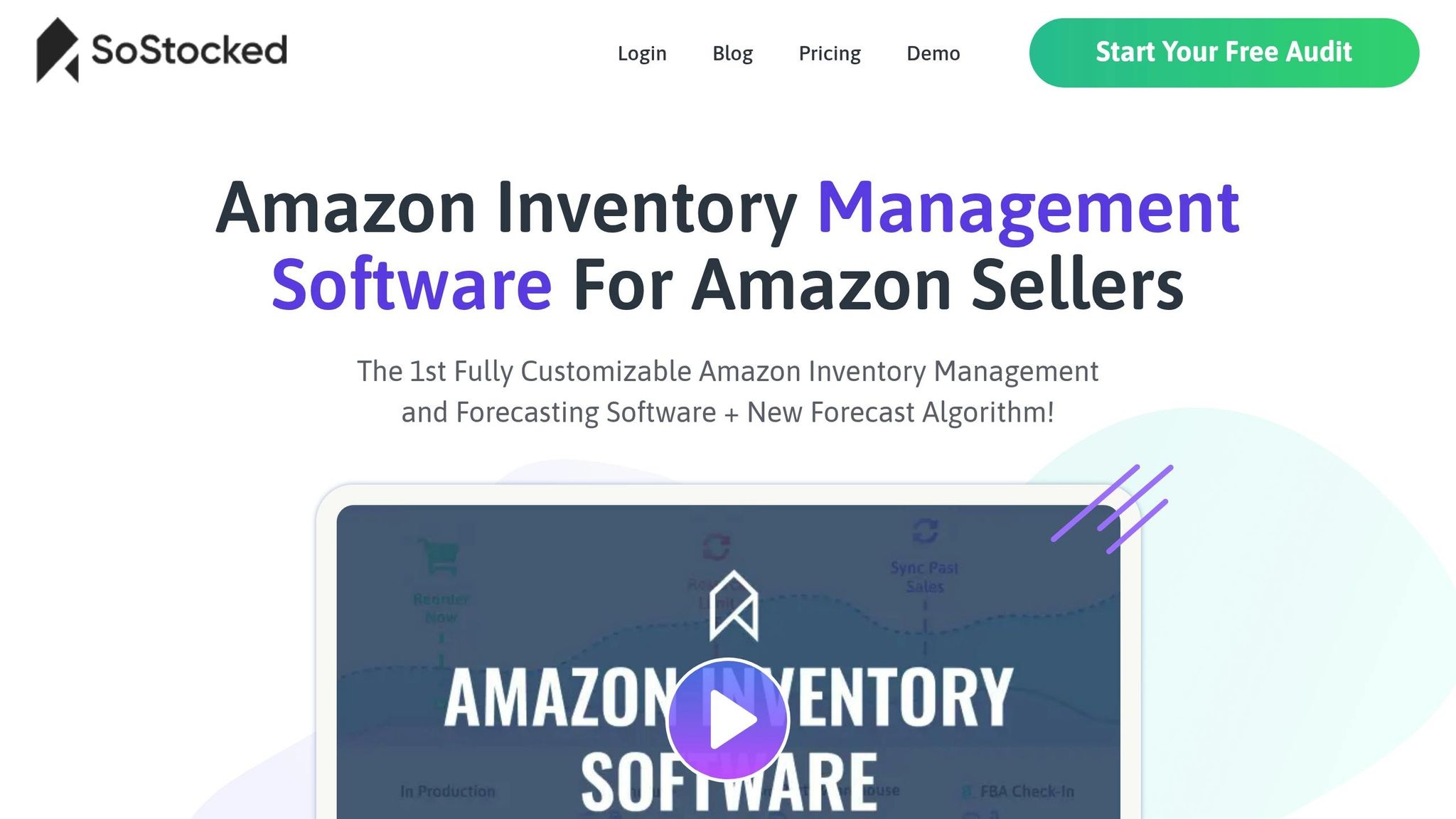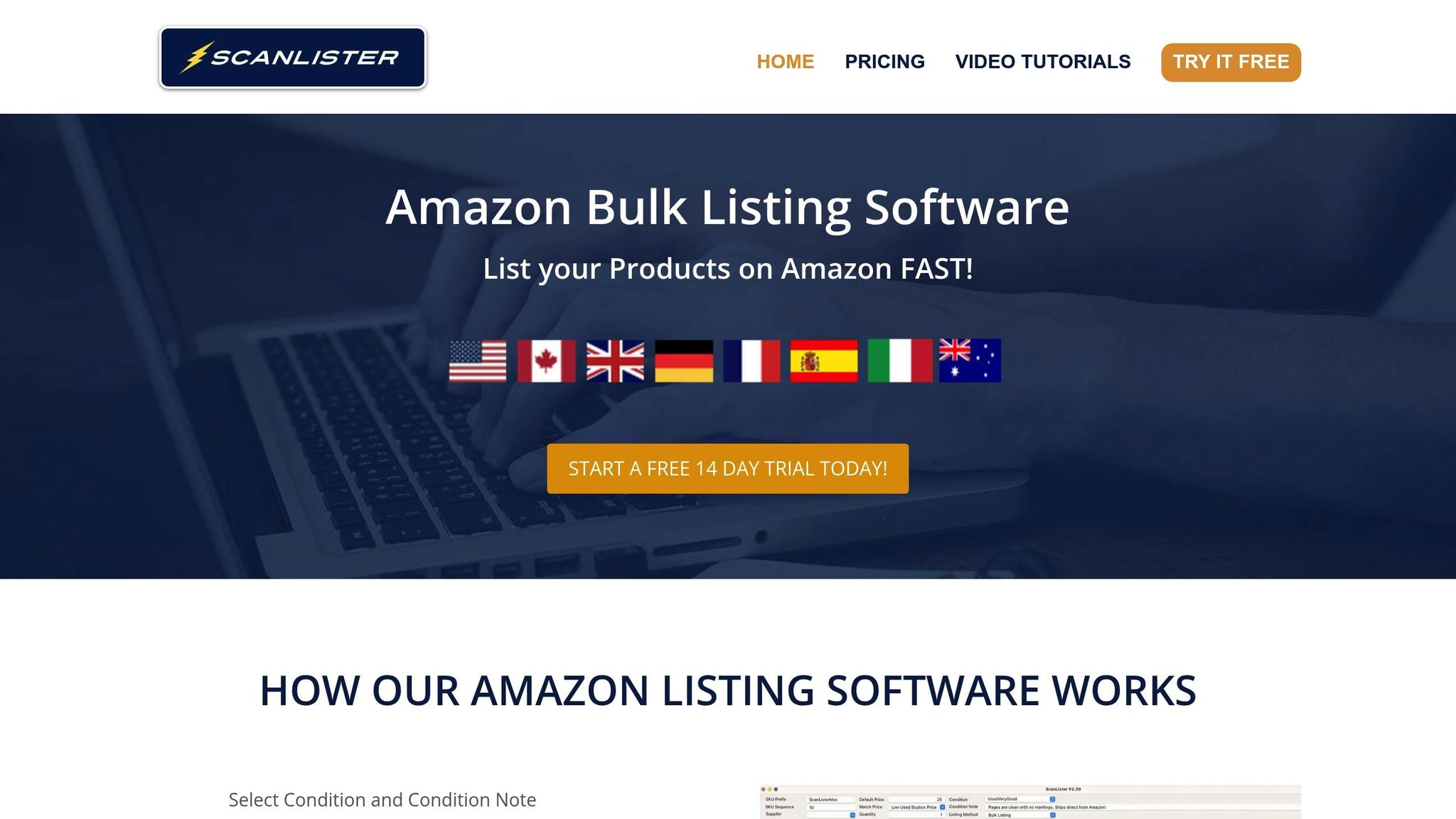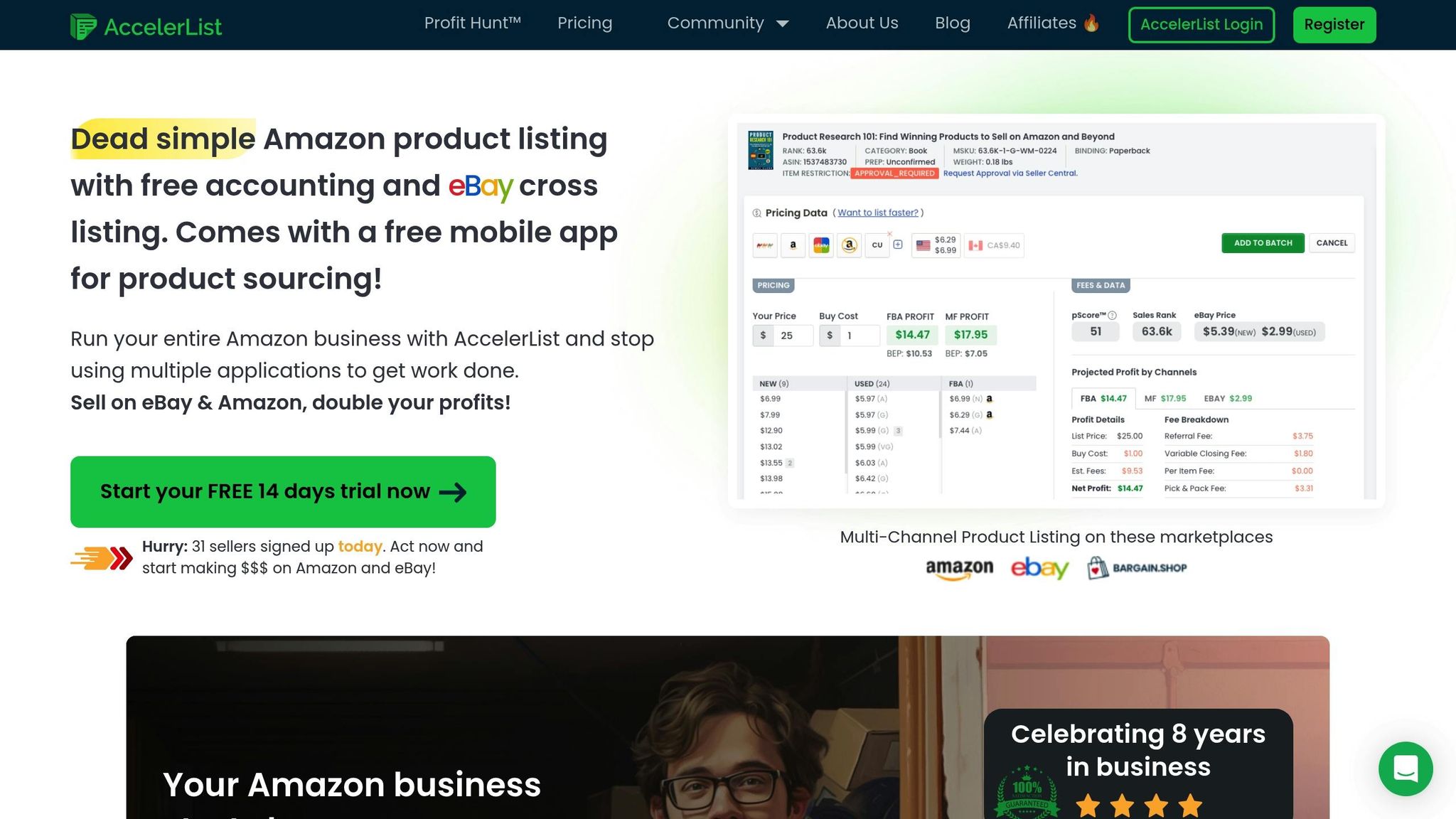Managing Amazon product listings can be overwhelming, especially for brands with hundreds or thousands of SKUs. From bulk updates to monitoring errors, the process requires tools that save time and reduce stress. Here’s a quick breakdown of the top software options to streamline your Amazon catalog management:
- FlatFilePro: Simplifies bulk updates, detects listing errors, and manages product variations with ease. Priced at $99/month, it’s ideal for growing brands managing 100–1,000 SKUs.
- InventoryLab: Combines catalog management with inventory tracking, offering detailed error reports and variation tools.
- SoStocked: Focuses on inventory forecasting while supporting bulk product imports and marketplace syncing.
- Scanlister: Automates product listings and organizes variations, with plans starting at $149/month.
- Accelerlist: Features scanning and batching tools for quick catalog updates, perfect for large inventories.
Each tool offers unique strengths, from automation to error detection, helping sellers optimize their listings and scale efficiently.
Best Amazon Listing Management Tools in 2025 🛠️📈 | AI, SEO & Multi-Channel Optimization
1. FlatFilePro
FlatFilePro was created by seasoned Amazon sellers to tackle the challenges of managing extensive product catalogs. It’s specifically tailored to help growing brands streamline their Amazon operations. Here’s a closer look at how its features simplify bulk product listing, error monitoring, variation management, and pricing.
Bulk Listing Capabilities
FlatFilePro’s bulk editing system leverages direct API integration, completely bypassing the need for traditional flat file uploads. This approach speeds up the process significantly – up to 10 times faster than using spreadsheets. For example, tasks that once took 2–3 hours with flat files can now be completed in just 15 minutes. Even massive updates, such as modifying over 1,000 listings, are done in under 5 minutes instead of the usual 40+ hours.
Beyond basic updates, the platform allows brands to modify titles, bullet points, descriptions, pricing, and even image assignments across their entire catalog all at once. This makes it especially useful when implementing new brand guidelines or adapting to Amazon’s ever-changing policies.
Error Detection & Monitoring
FlatFilePro’s Reflection Engine ensures your listings are accurate and up-to-date by scanning them nightly. It compares your intended content with what’s live on Amazon, using clear visual cues to highlight discrepancies – green checkmarks for correct listings and red Xs for errors. This automated system catches issues such as unauthorized content changes, policy-related suppressions, and missing information. By flagging these problems early, brands can maintain complete and polished listings without the need for exhaustive manual checks.
Variation Management
Managing parent–child product relationships can be tricky, but FlatFilePro’s drag-and-drop interface makes it straightforward. With a 95% success rate for variation updates (compared to 75% with traditional methods), the platform ensures updates are completed quickly – often in under 5 minutes. It handles complex scenarios like reassigning child products to new parent ASINs, creating new variation families, and fixing orphaned listings. This reduces the risk of errors that could disrupt your listings and lead to lost sales.
Pricing & Marketplace Integration
FlatFilePro offers a simple pricing model tailored to growing brands. The Standard plan is $99 per month, providing unlimited ASINs, full bulk editing capabilities, the Reflection Engine, and two marketplace connectors. Need to manage additional marketplaces? Each one costs $29 per month, making it easy to expand internationally without breaking the bank.
The platform supports major Amazon marketplaces, including the US, UK, Canada, Germany, and other European regions. With everything managed from a single dashboard, brands can oversee their global operations effortlessly. Plus, there are no long-term contracts, a 7-day trial (extendable), and a 6-month 100% money-back guarantee – giving brands the confidence to scale on their terms.
2. InventoryLab
InventoryLab combines catalog management with inventory tracking, offering a streamlined solution for sellers. Here’s a closer look at its standout features.
Bulk Listing Capabilities
With InventoryLab, you can easily import product data in bulk, simplifying the process of onboarding existing inventory. Once products are added, the platform automatically integrates them with its inventory tracking system, ensuring stock levels are monitored from the start.
Error Detection & Monitoring
InventoryLab goes beyond simple imports by providing detailed error reports during listing and shipment creation. These reports flag potential issues such as item-level restrictions, hazmat review requirements, missing dimensions, Brand Registry conflicts, meltable product limitations, and FBA restock thresholds [1].
Its Scoutify 2 app takes this a step further by offering Product & Category Restriction Alerts. When evaluating items, the app highlights restrictions with a blue Amazon restriction icon or an orange product alert button, breaking down the details to help sellers avoid listing prohibited products [3].
The platform also minimizes errors by enabling sellers to manage the entire process – listing, tracking, and shipping – within a single system. This reduces the need to switch between tools, cutting down on errors and saving time during shipment creation [2].
Variation Management
Handling variations is made simple with InventoryLab’s Parent/Child ASIN functionality and MSKU Customization. These tools allow sellers to create SKUs based on up to four variables, making it easy to manage products with multiple attributes. By setting up clear and systematic naming conventions, sellers can better organize and track their inventory [4].
3. SoStocked
SoStocked is a platform designed to help sellers manage inventory forecasting and streamline catalog operations. It focuses on maintaining balanced stock levels while simplifying the challenges of handling seasonal changes and business growth.
Bulk Listing Made Simple
With SoStocked, adding products in bulk is easy. Sellers can import product data using CSV files, cutting down on the time and effort spent on manual entries. The platform also integrates with Amazon’s API, allowing users to pull in existing product details seamlessly. This smooth data import process lays the groundwork for identifying and addressing potential issues before they escalate.
Keeping an Eye on Errors
SoStocked’s monitoring dashboard is like having an extra set of eyes on your operations. It keeps track of inventory levels, sales trends, and supplier performance. By flagging low stock, overstock, or supply chain hiccups early, it helps sellers avoid disruptions and stay ahead of problems.
Pricing Tools & Marketplace Sync
The platform also includes tools to manage costs, keeping tabs on fees and storage charges. Plus, it connects with major marketplaces to synchronize inventory, ensuring sellers don’t oversell or run into stock issues. This integration helps keep everything running smoothly across multiple sales channels.
sbb-itb-ed4fa17
4. Scanlister
Scanlister steps in to tackle the challenges faced by growing brands managing large product catalogs, offering tools designed to make catalog management smoother and more efficient.
Bulk Listing Made Easy
One of Scanlister’s standout features is its ability to simplify product listing through automation. Instead of manually entering product details, the platform pulls information directly from manufacturer databases and online sources. This streamlined process can cut listing creation time by as much as 75%, enabling sellers to quickly onboard hundreds of products while ensuring accuracy in titles, descriptions, and specifications.
Catching Errors Before They Go Live
Scanlister’s built-in quality control system is like having a second set of eyes on every listing. It automatically flags issues like missing images, incomplete details, or potential policy violations before the products are published. By cross-referencing product data with Amazon’s requirements, the platform identifies problems such as restricted categories, missing safety certifications, or non-compliant descriptions. This proactive process reduces the risk of listing suppressions and minimizes the need for fixes after publication.
Managing Product Variations
Dealing with product variations can be a headache, but Scanlister simplifies this with its intelligent grouping system. It automatically identifies related products based on attributes like brand and model, then creates parent-child relationships for variations such as size or color. This automated organization ensures consistency across entire product lines, saving time and effort.
Pricing and Seamless Integration
Scanlister’s pricing starts at $149 per month for up to 500 SKUs, with enterprise-level plans available for larger catalogs. It also integrates with major wholesale databases and supplier feeds, automatically updating product information and pricing whenever manufacturers make changes. This real-time synchronization keeps listings accurate and up-to-date without requiring constant manual adjustments.
5. Accelerlist
Accelerlist is a powerful tool designed to simplify catalog management, especially for sellers handling large volumes of inventory. Its standout feature is bulk listing, which allows users to manage multiple listings with ease. By enabling scanning and batching of items, Accelerlist helps streamline workflows and significantly reduces the time it takes to get products listed on Amazon, making the entire process faster and more efficient[5][6].
Comparison: Strengths and Weaknesses
FlatFilePro stands out as a solid choice for growing U.S. brands managing 100–1,000 SKUs, thanks to its impressive features and practical functionality. Let’s break down its strengths and potential limitations.
One of its standout features is the Reflection Engine, which automatically checks listings every night, flagging any unauthorized changes. On top of that, its bulk editing capability allows users to update hundreds of listings in just minutes. The drag-and-drop variation management system is also worth mentioning, boasting a 95% success rate in handling variation updates.
That said, brands with smaller inventories might find some of these advanced tools more than they currently need. However, for businesses on the rise, FlatFilePro’s direct API integration ensures quick, dependable updates, making it perfect for managing time-sensitive promotions. This combination of advanced tools and efficiency makes it a strong fit for brands looking to scale.
Another key advantage is the pricing. At $99 per month, with scalable add-ons available, FlatFilePro offers straightforward pricing that aligns with the needs of expanding Amazon brands, delivering both value and operational efficiency.
Conclusion
Picking the right Amazon catalog management software hinges on aligning the tool with your specific operational needs. It’s not about revisiting general business principles but focusing on what truly drives efficiency for your setup.
For smaller sellers working with tight budgets, it’s smart to opt for tools that handle bulk editing without unnecessary extras. Starting with the right solution early can save you from the hassle and expense of switching platforms down the line.
As we highlighted in our review of FlatFilePro, growing brands thrive with software that blends automation and manual control. Features like the Reflection Engine take the headache out of managing hundreds of products by cutting down on tedious monitoring. This kind of streamlined approach can pave the way for faster growth.
Another standout feature is direct API integration, which allows you to make updates in just minutes – perfect for managing high-stakes periods like seasonal sales or major promotions.
With pricing starting at $99 per month, the platform offers a cost-effective way to reduce manual labor and associated costs. Plus, its scalable pricing ensures it grows alongside your expanding catalog.
For international sellers, a platform that supports multiple marketplaces through a unified dashboard is key. This setup ensures consistent product information across regions and eliminates inefficiencies when managing global operations.
Finally, robust variation management is crucial for avoiding revenue dips during peak selling times. A reliable system can make all the difference when it matters most.
FAQs
Why is FlatFilePro a great choice for growing brands managing 100–1,000 SKUs on Amazon?
FlatFilePro is a smart solution for growing brands, especially those managing catalogs with 100–1,000 SKUs. It streamlines catalog management with powerful bulk editing tools, making it easier to update product listings, correct errors, and fine-tune your catalog. The result? Less time spent on manual tasks and more time to focus on growth.
The platform also helps brands recover lost revenue by quickly identifying and fixing listing issues. With its intuitive interface and automation features, FlatFilePro makes it simple for brands to scale their operations and enhance performance on Amazon without unnecessary hassle.
How does FlatFilePro’s Reflection Engine improve the accuracy and efficiency of Amazon product listing management?
FlatFilePro’s Reflection Engine takes the hassle out of managing Amazon product listings by automatically analyzing and validating your data before it’s uploaded. This means fewer errors, consistent formatting, and higher-quality listings across your entire catalog.
It also streamlines bulk data processing by spotting and flagging discrepancies in record time, making corrections faster and easier. With this level of automation, you can cut down on manual work, update your catalog more efficiently, and confidently manage anywhere from 100 to 1,000 SKUs as your brand continues to grow.
What are the advantages of using direct API integration for managing bulk Amazon catalog updates?
Using direct API integration for managing bulk updates in Amazon catalogs can make a world of difference for growing brands. It automates workflows, cutting down on manual updates and reducing the chances of errors in product listings. This makes handling large catalogs – ranging from 100 to 1,000 SKUs – far more manageable and efficient.
Another big plus? Direct API integration allows for real-time synchronization and quicker data transfers. This is key to keeping your catalog current and accurate. By simplifying operations, it not only saves valuable time but also boosts overall business efficiency, helping brands expand their operations with ease.

